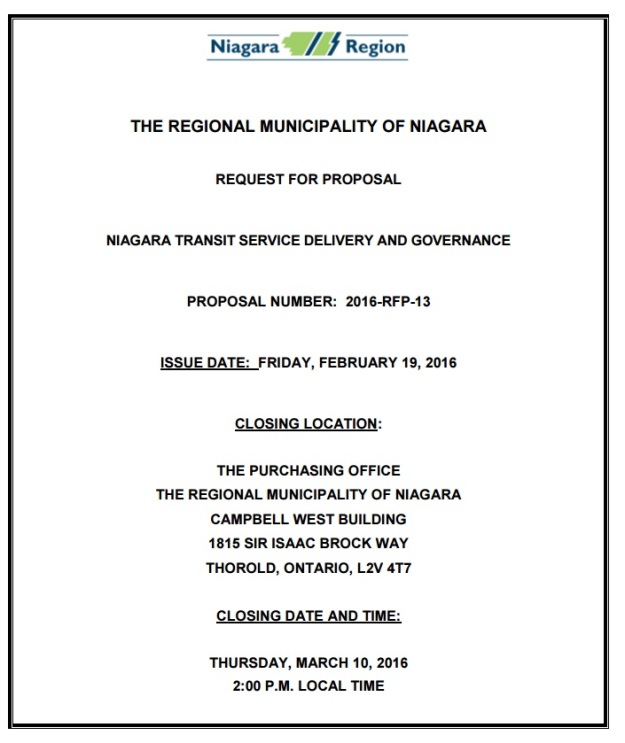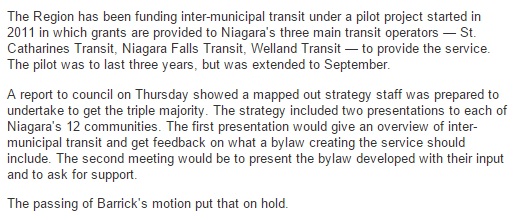Editor’s note: this post is the first of a few that will look at public transit in Niagara
Niagara has 8 public transit systems, or one for every 50,000 people. That’s too many public transit systems. Many believe having a single public transit system would be preferable, particularly for the user. Some believe improved public transit in Niagara is necessary to attract regular GO train service to Niagara.
Our 8 systems don’t integrate particularly well, if it all. Which makes sense; each of the eight systems serve a different master. Even within single public transit systems there are plenty of issues. For example, a large system like Niagara Falls has routes with only one bus an hour. Frustration with status quo has been expressed by many. For a long time. Are improvements on the way?
On Friday, Niagara Region issued a Request for Proposal (RFP) from consultants. It’s titled “Niagara Transit Service Delivery and Governance” and is valued at $150,000. (It might be coincidental, but Friday is known as the day to “bury” news; though I’ll give the Region the benefit of the doubt because RFPs are not typically newsworthy.)


The listed goal in Niagara Region’s public transit RFP
Where did this come from?
This RFP builds off the decision, last May, for the three largest Niagara municipalities (St. Catharines, Niagara Falls and Welland) to work together to provide a single, inter-municipal transit system. That decision halted the Region’s initial plan: work with the 12 lower-tier municipalities to move towards a single transit system.

The reason behind halting that and allowing the three largest municipalities to take over is seen in this excerpt from The St. Catharines Standard:

So, if the three municipalities are the experts, why (nearly a year later) is the Region (not the three cities) funding a consultant?
The likely short answers are time and parochialism. It is true that each of the three municipalities have transit staff that feature experts in public transit. But those experts already have full-time jobs that don’t provide the sort of downtime necessary for planning and implementing a Niagara-wide transit system. And, secondly, those full-time jobs are explicitly to work on behalf of the citizens of one municipality.
Hence, the Region has remained part of the transit working group and that group determined a neutral party (consultant) is required to help plan the system. Except, this is what the Region was already offering to do before being halted last Spring. In fact, the Region used the same method to garner expertise as it is now: consultants’ reports.
Here are 4 from a recent five year period, all delivered to Niagara Region.
- Inter-Municipal Transit Work-Plan, Phase 1 – ENTRA, October 2009 [96 pages]
- Inter-Municipal Transit Work-Plan, Phase 2 – ENTRA, May 2010 [92 pages]
- Transit Governance Review – AECOM, 2013 [75 pages]
- 10 year inter-municipal transit service concept – Dillon Consulting, 2014 [75 pages]
1 and 2 from the list preceded the inter-municipal transit pilot project. The recommendations influenced the founding of Niagara Region Transit, but many key recommendations were ignored, including a $4.50 fare and half-hour service during peak times.
3 was an overview and comparison of governance models. It was largely ignored.
4 included a detailed plan of how to move inter-municipal transit forward over the next ten years. It included a service map, and a high-demand and low-demand scenario for specific costs and ridership. On the surface, the report being requested now is asking for similar things.

10-Year Plan Map from Dillon Report
So how does this new report differ? Will it change anything? What new can be said after nearly 350 pages of consultants reports, costing hundreds of thousands of dollars, since 2009? How likely is it that we will finally see a united public transit system in Niagara?
Those questions and more in the next “Public Transit in Niagara” post.

